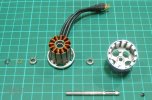D
Deleted member 103366
Guest
This question just popped into my mind.
When stopping them after landing they do seem to stop rather quickly. It made me wonder whether they actively brake them or rely on the interaction of the magnetic fields and or air resistance or all three.
When stopping them after landing they do seem to stop rather quickly. It made me wonder whether they actively brake them or rely on the interaction of the magnetic fields and or air resistance or all three.
Last edited by a moderator:











